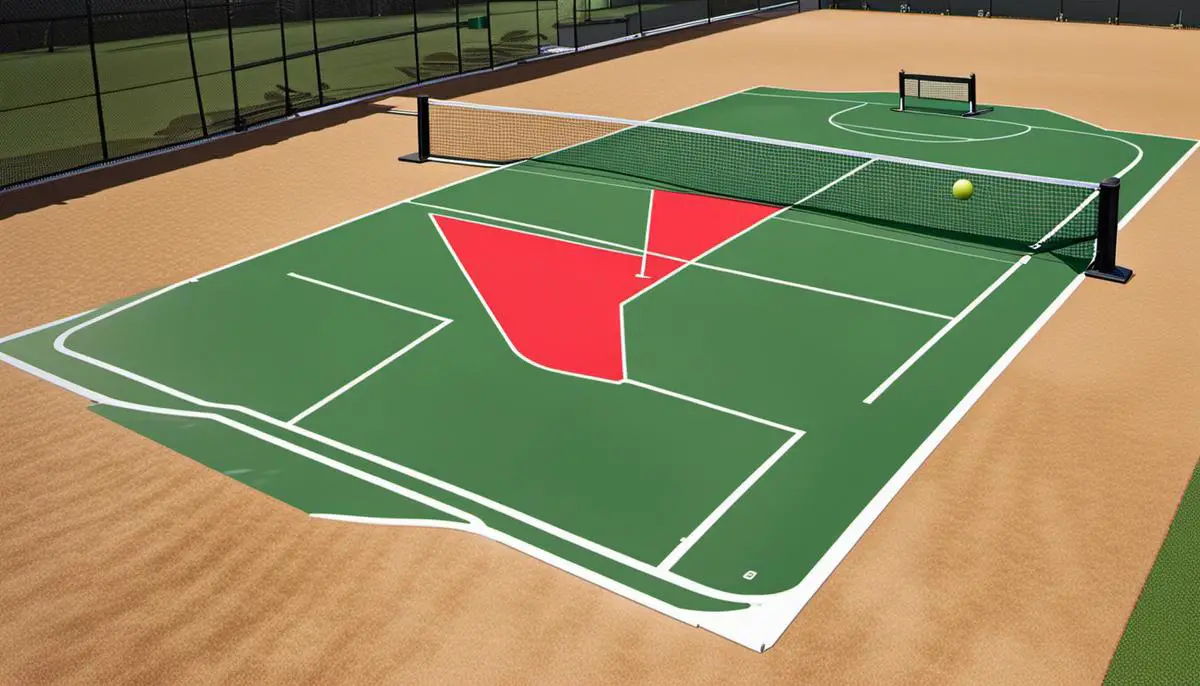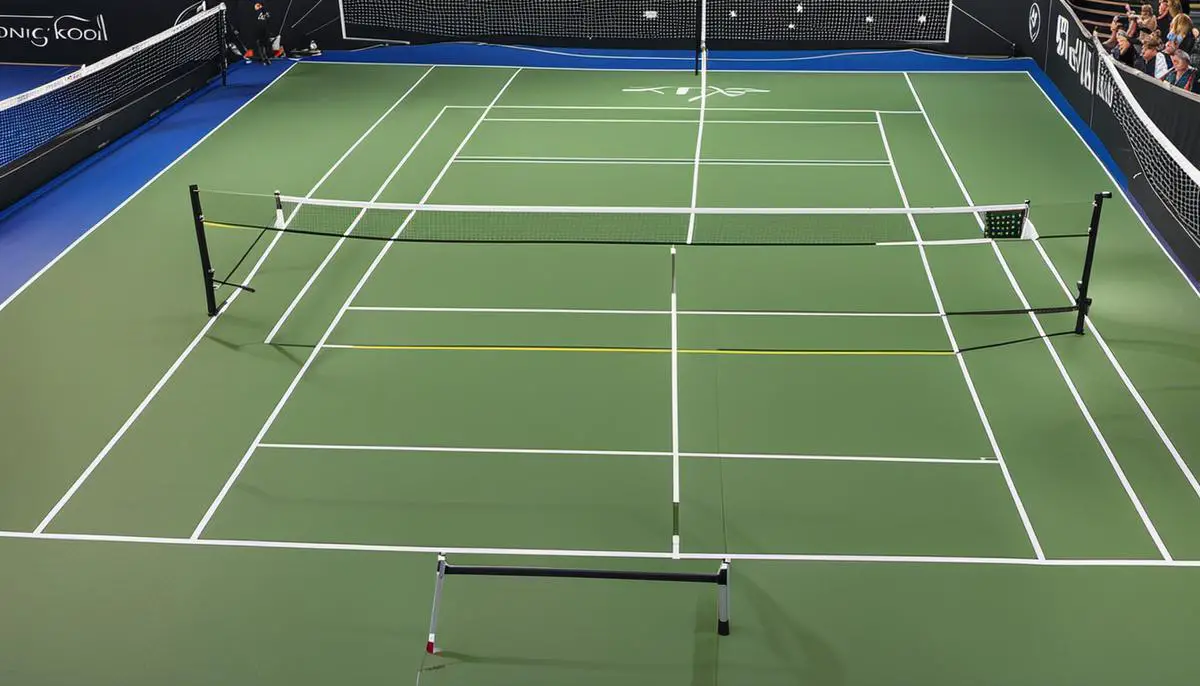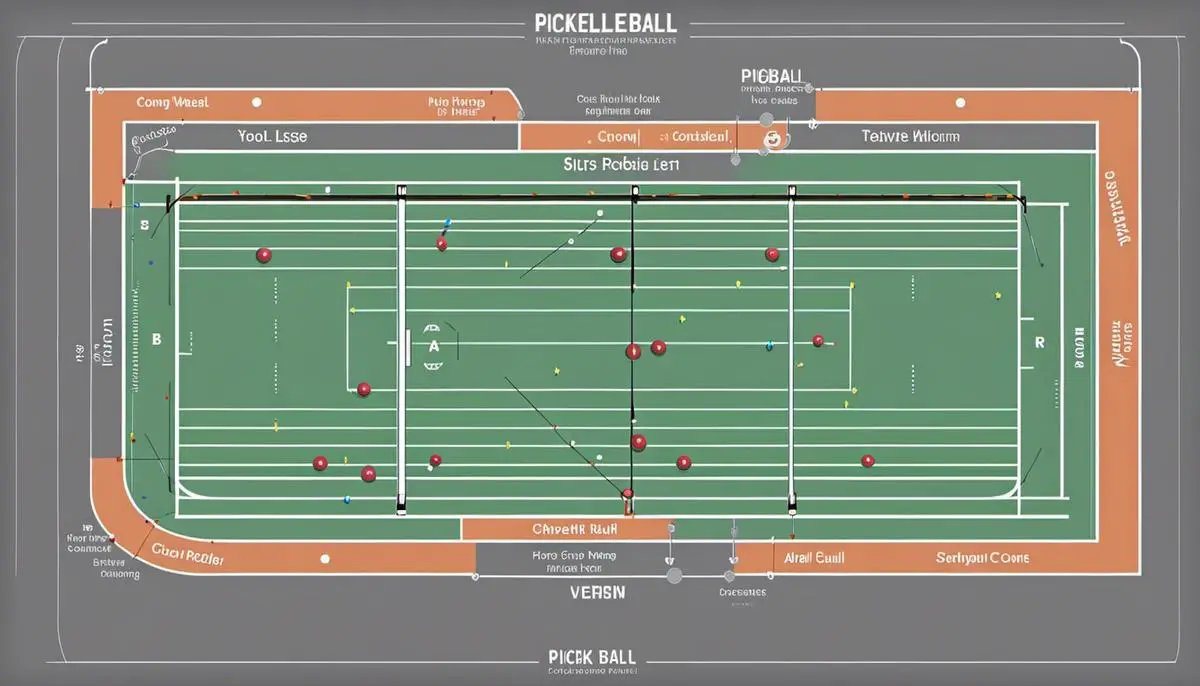As an enthusiastic participant or an avid spectator of the rapidly growing sport of pickleball, gaining a comprehensive understanding of the basic standards for pickleball court dimensions can enrich your experience. The foundations of the game aren’t just confined to the rules and skills, but equally pivotal are aspects such as the court measurements and markings, set by the International Federation of Pickleball. This incorporates knowledge about the court’s size, non-volley zones, service boxes, and numerous other intricacies that share similarities with a badminton court. Furthermore, the art of setting up a pickleball court accurately, whether it’s for a casual match in your backyard or for an official tournament inside a sports facility, adds a whole new layer of intrigue to the sport.
Basic Standards for Pickleball Court Dimensions
Standard Dimensions of a Pickleball Court
The standard measurements of a pickleball court, established by the International Federation of Pickleball, dictate the overall size of the court. The dimensions for such a court are 20 feet wide by 44 feet long, similar in size to a badminton court.
Understanding the Non-Volley Zone or Kitchen
The non-volley zone, colloquially known as the “kitchen,” is an integral part of the pickleball court. The kitchen is a seven-foot deep area extending from the net on either side of the court. Serving into this area is prohibited, creating a unique challenge for the players.
Service Boxes in Pickleball
The final dimension to understand in a pickleball court is the Service Boxes. These areas are 15 feet long and 10 feet wide, and they reside on both sides, left and right, of the court. The server must stand within these clearly marked boxes when serving the ball, ensuring a fair and consistent start to each play.
Line Measurements
In addition to the overall dimensions, lines in the pickleball court also follow standard thickness. Sidelines and baseline should have a width of 2 inches. However, it’s recommended that the non-volley line, also referred to as the kitchen line, measures at least 2 inches in width. This differentiation helps players visually distinguish this crucial area on the court.
The dimensions of a pickleball court are instrumental in shaping the rule and gameplay. Knowledge of the correct measurements not only aids in setting up a new court but also enhances the playing experience by offering a standardized play area.

Setting Up a Pickleball Court
Understanding Pickleball Court Dimensions
Pickleball, similar to tennis, requires a specific court size in order to play. Officially, a pickleball court is a rectangle 20 feet wide (6.10 meters) and 44 feet long (13.41 meters) for both singles and doubles play. The non-volley zone, also referred to as the “kitchen,” is situated within 7 feet from the net on either side. It is crucial to accurately mark out these dimensions for a proper setup.
Materials for Setting Up a Pickleball Court
The materials you’ll need to set up a pickleball court include a measuring tape, chalk or paint, and string or rope. Depending on whether you are setting up the court indoors or outdoors, you might need additional materials. An indoor court may need painter’s tape or a permanent marker, whilst an outdoor court may need a grass-friendly paint or temporary marking spray.
Marking a Pickleball Court with Accuracy
Start marking the dimensions of your court using a measuring tape. Using ropes or strings attached to pegs can help ensure your lines are straight. Begin by outlining the full rectangle of the court (20 X 44 feet), then, within your rectangle, measure and mark out the ‘kitchen’ area 7 feet from the net on both sides. All lines should be 2 inches wide. To ensure measurements are accurate, consider double-checking all dimensions before applying permanent or semi-permanent lines.
Outdoor Pickleball Court Setup
Outdoor pickleball courts can be set up on any flat area larger than the court size. A lawn, driveway, or parking lot could all be suitable locations. The lines can be marked with a chalk or grass-friendly paint, ensuring they are clear and visible. Do consider that the boundaries must be away from walls, fences, and other potential hazards.
Indoor Pickleball Court Setup
Indoor courts can be set up in a gymnasium, warehouse, or potentially a large garage. Interior courts can use the existing marking for other court sports or you can create the court using adhesive painter’s tape or permanent marker for the lines if appropriate. Keep in mind that the floor surface should be safe for sprinting and quick lateral movements, thus carpeting is not advisable.
Safety Considerations in Setting Up a Pickleball Court
Players’ safety should be a top priority when setting up a pickleball court. The court surface should be flat, clear, and free of any obstruction or slipping hazards. The net posts should be securely installed to avoid accidents. Material used for marking should not be slippery when wet. Players should have plenty of room to move around the court – a minimum of 10 feet on all sides is recommended. Depending on the court’s location, you may also need to consider external factors such as pedestrian traffic or nearby roads.

Deciphering Pickleball Court Lines and Zones
Pickleball Court: Breaking Down the Basics
Before understanding the intricate nuances of the game of pickleball, it is imperative to understand the layout of the pickleball court. The pickleball court is a rectangle measuring 20 feet wide by 44 feet long.
Baselines and Sidelines: Understanding the Boundaries
On the long sides of the rectangle, you have the baselines. These mark the outer boundaries of the court, making the length of the pickleball court. On the shorter sides, there are sidelines. The sidelines are just like baselines but run vertically, indicating the width of the court.
Centerline and Service Lines: Defining the Serving Areas
Within the sidelines and baselines, you will find the center line and the service lines. The centerline bifurcates the serving areas into left and right service courts. Begins from behind the non-volley zone, it divides the area behind it into two equal rectangles. Service lines run parallel to the baselines and dictate where serves can be made from.
The Non-Volley Zone: Area of Caution
The non-volley line starts 7 feet away from both sides of the net, creating an area which is called the ‘non-volley zone’. Also known as ‘the kitchen’, the region draws a boundary within which volleys are impermissible. A volley is a shot that is hit before the ball bounces on the ground, and this line is crucial in regulating the distinct ‘bounce’ rule in pickleball.
How the lines impact gameplay
These lines collectively define the boundaries and rules within which the game is played. For instance, for the serve, the server must keep both feet behind the baseline. The ball must land within the opposite diagonal box across the net without touching any of the lines. Sidelines and centerlines define fair play and help in judging whether the ball is out or in. The non-volley line prevents players from smashing the ball close to the net, helping to maintain balanced gameplay. These lines guide the gameplay and let the players, referees, and audience understand the unfolding action on the court.

Consequently, diving deeper into the understanding of pickleball court lines and zones can truly augment your pickleball experience. It serves as the bedrock that supports your knowledge of the game and cements your understanding of the sport’s logistics. From baselines to service lines and everything in between, every marked zone plays a significant role in shaping the competitive and thrilling nature of pickleball matches. So, bolster your pickleball knowledge, whether you’re a player, an organizer, or a fan, because each aspect of this captivating sport—just like each line and zone on the court—adds its unique essence to the overall experience.